|
The Foot and the Horse!
|
|
|
|
|
| Part
One of Two The Model 1832 Foot Artillery Sword
|
|
|
On June 5, 1832 Nathan P. Ames, Jr., then 29, signed a contract
with the U.S. Ordnance Department to produce 2,000 Model 1832 Foot
Artillery swords with scabbards. This was the first of a long line
of edged weapons contracts that would give birth, in 1834, to the
Ames Manufacturing Company of Chicopee Falls, Mass. established
by Nathan Peabody Ames, Jr., 31, and his younger brother, James
Tyler Ames, 24. The company would become the leading manufacturer
of edged weapons engaged by the U.S. government in the nineteen
century. Not only would they produce swords and sabers but cutlasses,
knives and bayonets, as well as firearms and cannon. A cannon
foundry would be established, two years later, on the Chicopee River
a mile or so below the falls which in itself begot the town of Cabotsville.
Cabotsville and Chicopee Falls later merged into the single community
of Chicopee, Mass located near the federal armory at Springfield.
His initial blacksmithery was apparently close enough for Ames to
stamp "SPRINGFIELD" on the blades of his first foot artillery
swords. Later swords would be stamped or etched with the addresses
of "CABOTSVILLE" or "CHICOPEE".
|
|
|
|
|

THE FIRST OF THE FIRST - THE AMES MODEL 1832 FOOT ARTILLERY SWORD DATED 1832
|
|
|
This sword was based on a the French Artillery Model of 1816. It
resembles in shape and size the modern conception of the Roman infantry
sword. One of the design and assignment considerations was it's
use against cavalry. Since cavalry loved to take artillery positions
- like the Charge of the Light Brigade, it was thought that the
heavy or foot artillery man using this weapon could rip open the
horses belly's or break their legs as they leapt over the revetments
protecting the cannon emplacements. And then they could dispatch
the fallen riders with it! Sure. U.S. Ordnance Department manuals
for 1834 and 1839 also advocated the use of this weapon by infantry!
In truth and usage, this sword suffered from the "toos". It was
too heavy, it was too short, it was too unwieldy and it was, tactically,
too unsound. Since the cavalry men were carrying six shooters and
a much longer sword, any artillery man holding his ground or attempting
to attack the horse or it's rider was at a distinct disadvantage.
He might as well fall on his own sword. The earlier Ames swords
would also suffer from loose blades after hitting them on a wooden
block a few times. Ames changed the inner castings to solve this
problem in 1834 and they were given a contract for 2,400 more. Ames,
due to limited production facilities had sub-contracted out the
the manufacture of the earlier brass hilts to Samuel Huse who had
a foundry in nearby Newburyport, Massachusetts. In 1834 Ames started
producing the improved hilts at their Chicopee Falls factory canceling
the sub-contract to Huse. Swords dated 1835 and later have the improved
hilts. Ames continued to produce a total of 20,100 foot artillery
swords with the last delivery of 300 being May 24, 1862. Despite
all the "toos", this sword continued to serve the foot artillery
until 1870. There were numerous variations made over the years in
fullers, with and without, blade markings as to addresses and of
the Ames company marking. Some saw Navy usage as well. In CIVIL
WAR SMALL ARMS OF THE U.S NAVY AND MARINE CORPS by John D. McAulay,
he documents the fact that the Army sent the Mississippi Squadron
300 Model 1832 foot artillery swords for the use of the fleet in
February of 1862. There is also reference to 20 Artillery Swords
being supplied by the Watervliet Arsenal in 1852 to Perry's flag
ship, the Mississippi, for it's expedition to Japan. Pre Civil
War Naval small arms inventories list such items under swords as
"Ames-Pattern", "Roman", "cutlasses" and under cutlass as "Roman",
"Curved" and "Straight". Later listings are noted that show
"boarding swords" and "cutlasses" as separate weapons. It is perfectly
conceivable that in the 9 years between the issuance of the Model
1832 Artillery Sword and the Model 1841 Naval Cutlass that more
than a few Model 1832 Artillery Swords could be found in Naval inventories.
The sword featured here is in a French or European manufactured
scabbard for the French Artillery Model of 1816 "Coupe - choux"
which served as the pattern for the U.S. Model 1832 Foot Artillery
sword. This scabbard has been with this sword for it's known history.
There is an anchor stamping on the obverse of the scabbard throat.
|
|

FOOT ARTILLERY SWORD IN SCABBARD
|

FOOT ARTILLERY SWORD W/O SCABBARD |
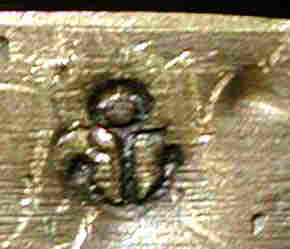 |
|
| ANCHOR
STAMPING - SCABBARD THROAT
|
|
|
|
|
|
The 1832 dated Ames Foot Artillery sword featured here has
a straight, delicately wasp shaped blade. It is double edged and
elliptical in cross-section. There are two side by side broad lower
fullers, starting 1-1/16" from the hilt that are each 3-9/16" long
by 7/16" wide. Then, after a space of 11/16", there is a single
broad 7/16" wide center fuller that extends 10-7/16" towards the
blade's spear shaped point. The over all blade length is 18-15/16''.
The blade is 1-3/4" wide at the hilt then curves inward to 1-9/16"
before flaring out again to 1-3/4" and tapering gracefully to it's
point. The blade is stamped on the reverse, near the hilt "UNITED
/ STATES / 1832" in 3 lines. On the obverse, near the hilt,
stamped under an American eagle, is "N. P. AMES / SPRINGFIELD" in
2 lines. The 6-1/8" long hilt and cross guard are stamped brass.
The grips have been molded in a scalloped eagle feather design.
Three transverse iron rivets secure it to the tang of the blade.
The tribolated pommel is decorated on each side with a heavily incised
American eagle, with shield, holding arrows in his left talon and
a olive branch in his right talon. The eagle's head faces towards
it's right. The straight cross quillons terminate in disk shaped
finials and are 4-7/32" across. On the top flat of the cross guard,
on the obverse blade side looking down, is the horizontal
stamping of "'S. HUSE" over "NEWBURYPORT ". To the right of that
stamping, running vertically next to the finial is the stamping
of "J.A.J.B." within a lined border. These are the initials
of James A. J. Bradford, an Army inspector. On the top flat of the
other quillon is a stamped "M". This is thought to denote the Commonwealth
of Massachusetts. The sword is 25"+/- over all. The French or European
made scabbard is black leather with a brass throat and tip.
|
|

LOWER BLADE FULLERS
|
UPPER BLADE FULLER
|
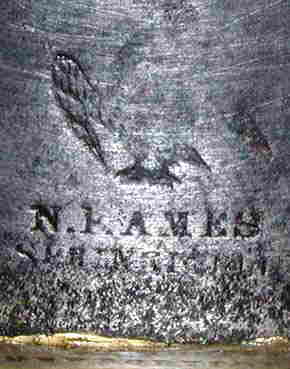
OBVERSE
BLADE STAMPING
|
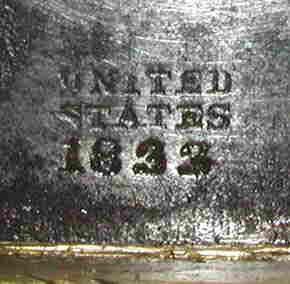
REVERSE
BLADE STAMPING
|

OBVERSE VIEW - HILT
|
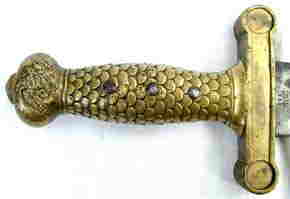
REVERSE VIEW - HILT
|

OBVERSE VIEW - POMMEL
|
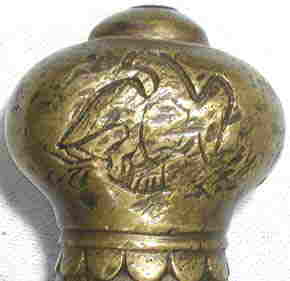
REVERSE VIEW - POMMEL
|
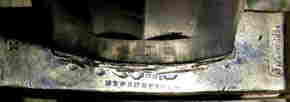
CROSS GUARD STAMPINGS
|

" S. HUSE / NEWBURYPORT" STAMPING - CLOSE UP
|

" J. A. J. B." INSPECTOR'S INITIALS CROSS GUARD
|
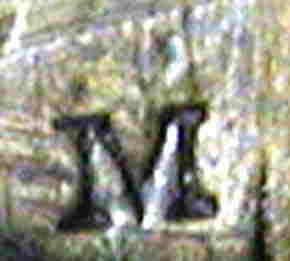
"M" STAMPING CROSS GUARD (COMMONWEALTH OF MASSACHUSETTS ?)
|
|
|
|
|
This probable French made scabbard is 19-5/8" over all and 2" wide.
The brass throat is 1-11/16" long and the brass tip measures 4-3/32".
Both the throat and tip are secured by 3/8" long horizontal brass
stables on both the obverse and reverse. There is a 1/8" thick inleted
brass bar 1/2" from the top of the obverse throat. It measures 1-1/8"
over all with an inside measurement of 7/8" for attaching to a frog.
It extends out from the throat about 1/4". Centered above the brass
bar at the top of the throat is a anchor stamping that may have
been added after issuance of this French sword scabbard. A close-up
of that stamping is shown above.
|
|
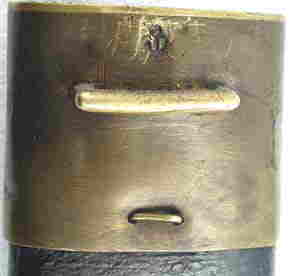
OBVERSE
OF SCABBARD THROAT
|

TOP
VIEW OF SCABBARD THROAT
|
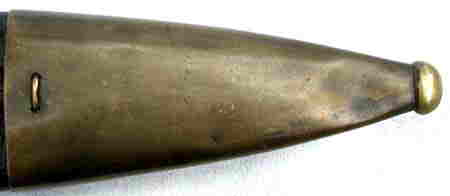
SCABBARD
TIP
|
|
|
|
|
|
Reference credits go to the "COLLECTORS' GUIDE TO AMES U.S. CONTRACT
MILITARY EDGED WEAPONS: 1832 - 1906" by Ron G. Hickox , "CIVIL WAR
SMALL ARMS OF THE U.S. NAVY AND MARINE CORPS" by John D. McAulay
and the classic "THE AMERICAN SWORD 1775-1945" by Harold L. Peterson.
|
|
|
For more on the Ames Sword Company, you are encouraged to look at
the following web pages:
http://www.amessword.com/body_index.html http://www.manatarmsbooks.com/early.html http://swordcoll.www2.50megs.com/marks/Manufacturers.htm
|
|
|
Once again, my son Reed Radcliffe, who is also the web master of
this page, gets all the credit for arranging and posting this web
page. The pictures, this write-up, errors in judgment and assumptions
are mine as are any awkward sentences or spelling errors.
|
|
|
Part 2 of 2 on Ames artillery swords will be posted, God willing,
in about 7 to 10 days. Part 2 is titled:
|
|
|
|
|

Note: Although designated as the Model 1840 Light Artillery Saber, The Ames Sword Company did not receive a government contract for this model sword until 1844 with delivery commencing in 1845. Therefore it is sometimes referred to as the Ames Model of 1844 Horse or Light Artillery Saber.
|
|
| Dave
Radcliffe
|
|